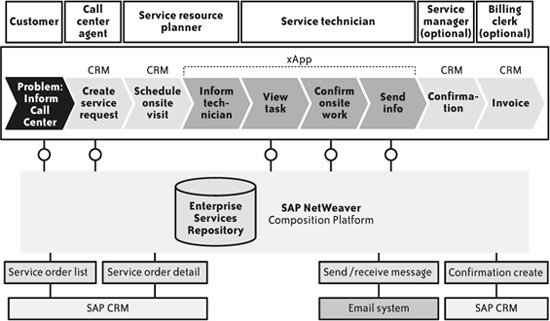Section 10.3. ESA in CRM: service request processing
10.3. ESA in CRM: service request processingAs SAP continues its work to enhance its classic suite of packaged applications with enterprise services, new opportunities to extend their flexibility and versatility via xApps created using ESA principles are already starting to emerge. One such xApp was created in just 10 days by SAP's solution management team to fill a gap in functionality in mySAP Customer Relationship Management (mySAP CRM). Most Customer Relationship Management (CRM) service applications were originally envisioned as tools for managing in-house teams of service representatives. But just as the business vision has changed for many companies, so has the assumption that CRM roles will remain internal. The outsourcing of these duties to third parties has increased the strain on the underlying IT, leading to difficulties in incorporating those parties into the smooth workflow enjoyed by internal participants. As mySAP CRM is currently configured, a matter as simple as arranging a repair visit by a third-party technician requires manual notification and confirmation of the appointment and inevitably concludes with the third party having to file a paper bill that then needs to be input into the CRM system. What is an otherwise automated system begins to be exposed as inefficient and error-prone when external services are required. SAP set out to solve this problem by creating an xApp that simply extended a business process that involved the CRM Customer Interaction Center (CIC), Workflow Management (WFM), and CRM Service. The resulting composite application collects all the relevant information to allow external service providers to handle the job in question. Fields containing all of the pertinent detailsthe date, time, duration, and location of the appointment, along with the name of the customer in question, the point of contact, the order number, etc.are entered into the xApp, which then automatically generates Adobe forms containing this data and emails a PDF file to the external service provider. These forms are linked to the CRM backend. Later, after the repairs have been completed, the service provider enters final confirmation datahow long repairs took, what parts were needed, the cost of those parts, etc.and sends it to the CRM backend. The confirmation data is also used to start the billing process for the service provider, replacing the paper forms that the provider previously had to complete by hand and submit by mail and which in-house staff then entered into the system. Every field on the form corresponds with a field in the CRM application; the Adobe forms act as the intermediary, and the xApp smoothly automates and integrates the entire process. Behind the scenes, enterprise services culled from mySAP CRM supply the xApp's underlying functionality. Figure 10-3 illustrates both the new business process steps created by the xApp, and the corresponding enterprise services, shown near the bottom. "Service order list" generates a list of service orders for a specific business partner (for example, all open service tickets for an external service provider). "Service order detail" shows all relevant data for a single service order and "send/receive message" creates the framework for passing the Adobe forms to the external service provider via email. "Confirmation create" enables the user of the Adobe forms to create and send confirmation data to the backend. Figure 10-3. CRM: service request processing The benefits of this xApp were immediately evident to its creators. The automated process replaced an ad hoc exchange of emails and phone calls, thus reducing errors, increasing productivity, improving data collection, and accelerating the customer billing process. More important, it acts as a model for future lightweight applications, which can literally be assembled and configured in days, and are capable of bridging the gaps between the fixed business processes supported by packaged applications and the increasingly flexible markets facing most companies today. |
EAN: 2147483647
Pages: 265